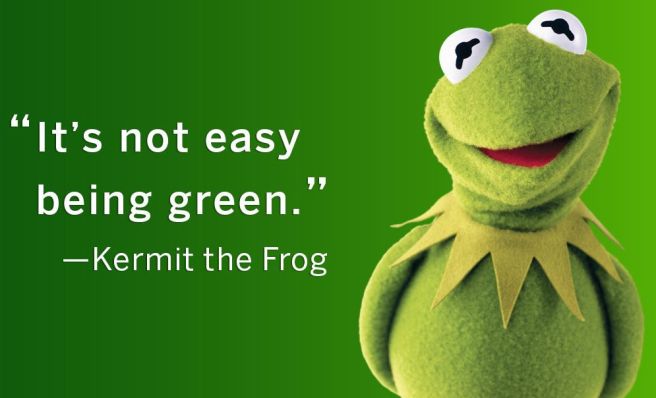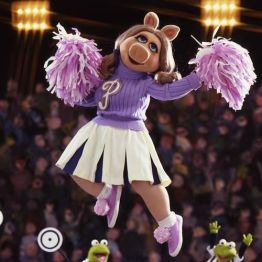It’s not that easy being green
Having to spend each day the colour of the leaves
When I think it could be nicer being red or yellow or gold
Or something much more colourful like thatIt’s not that easy being green
It seems to blend in with so many other ordinary things
And people tend to pass you over
‘Cause you’re not standing out like flashy sparkles on the water
Or stars in the skyBut green is the colour of spring
And green can be cool and friendly-like
And green can be big like an ocean or important like a mountain
Or tall like a treeBut if green is all there is to be
It could make you wonder why, but why wonder, why wonder
I’m green and it’ll do fine
And it’s beautiful and I think it’s what I want to be.

Ostensibly, this song laments what it’s like to be ordinary, but for the neurodiverse it has an alternate meaning.
I try to keep this blog about my journey through education and motherhood, but it’s awfully hard to keep strictly to that because both of those activities involve other people — students and my own children. I realize my kiddos may someday want to read my posts (actually, I find that quite unlikely), and I want to protect their privacy; however, I also want to be the voice of concern for other children who have similar struggles (and breakthroughs!). That’s why I feel it’s important to write about neurodiversity.
Those Who are Green
According to the CDC’s National Survey of Children’s Health, approximately 9.4%, which is 6.1 million, children (2-17 years of age) in the United States have received a diagnosis of ADHD — an umbrella term for neurodiversity. (It’s not a condition that can be outgrown or “cured” but can be treated. If you have not read a recent medical definition of ADHD, you probably do not know what it is. I implore you to do so now before continuing to read.)
Among children with ADHD, two-thirds of them have at least one of the following comorbid (co-occurring) conditions:
- anxiety
- behavior or conduct problem
- depression
- autism spectrum disorder
- Tourette Syndrome
- obsessive-compulsive disorder
On top of that, the CDC also reports that half of all school-age children with an ADHD diagnosis have one or more learning disorder following into these categories:
- Dyslexia – difficulty with reading
- Dyscalculia – difficulty with math
- Dysgraphia – difficulty with writing
If you are following these statistics, you should be imagining a pie chart where 90% of the pie is already gone, and the remaining 10% is being carved into smaller and smaller slivers. Those leftover slivers of pie are the neurodiverse kids in your life. On paper they might look like this:
- ADHD, anxiety, depression, autism spectrum disorder, dyscalculia
- ADHD, Tourette Syndrome
- ADHD, behavior disorder (plus, just to make things fun, intellectual giftedness)
- ADHD, anxiety, depression, dysgraphia, dyslexia, intellectual giftedness
- ADHD, anxiety, obsessive-compulsive disorder
It’s Not Easy
Of course, a child is far more than a laundry list of diagnoses, but I want you to see that no two neurodiverse children are the same (even within matching diagnoses, there are spectrums of intensity), and that can make it difficult to band together. In fact, rather than rallying to each other’s sides, neurodiverse kids can be less likely to get along with each other!
No matter how children may struggle with their neurological hardwiring and learning disorders, there is one common theme among them: shame. Doctors Ned Hallowell, M.D., and William Dodson, M.D., (both members of the specialist panel for ADDitude Magazine) discussed this problem in a recent podcast titled From ADHD Shame and Stigma to Pride and Truth.
Dr. Dodson defines “shame” as “feeling bad about who and what you are” and differentiates it from “guilt,” which is “feeling bad about what you did.” Shame comes from a person’s understanding of what’s valuable about them as well as what is not valuable about them. It’s the painful feeling that we know about but we hide from other people.
As children, we internalize praise and see that as a good part of us, but we also  internalize punishment and see that as a bad part of ourselves. Praise and punishment are not always intentional (or fair). A naturally intelligent child might be praised for doing well on an assignment that was easy and required little effort while a slow processing child might be punished with remarks like, “Hurry up! You’re taking too long!” on an assignment for which they are giving maximum effort. For better or worse, rewards and punishment are how we learn who we are and what the world expects us to be and do. By middle-adolescence, we begin to have a solidified idea of who we are. As a classroom teacher, nothing makes me happier than to see an opportunity to genuinely praise a student who isn’t accustomed to receiving it.
internalize punishment and see that as a bad part of ourselves. Praise and punishment are not always intentional (or fair). A naturally intelligent child might be praised for doing well on an assignment that was easy and required little effort while a slow processing child might be punished with remarks like, “Hurry up! You’re taking too long!” on an assignment for which they are giving maximum effort. For better or worse, rewards and punishment are how we learn who we are and what the world expects us to be and do. By middle-adolescence, we begin to have a solidified idea of who we are. As a classroom teacher, nothing makes me happier than to see an opportunity to genuinely praise a student who isn’t accustomed to receiving it.
Dr. Dodson also says that shame is the “master emotion,” because all other emotions (like happiness or sadness or disgust) seek expression. In those cases, we want people to know how we feel, but shame hides itself. We don’t want others to know we feel shameful. Concealed inside our head, shame begins to govern our expression of our other emotions and to change how we perceive the world and ourselves.
Culture is a set of standards that are expected to be upheld. If you don’t (or can’t) uphold those standards, you may be (outwardly) stigmatized and (inwardly) feel ashamed. Being like everyone else is an extremely valuable quality, especially in adolescence. For neurodiverse people, upholding cultural standards can be difficult at best. It may take every ounce of effort and focus for the hyperactive child stay seated, the OCD child to stop a repetitive thought, the anxious child to relax their fears, the child with autism to stop self-stimulatory behaviors, and the child with Tourettes to suppress a tic. With all their effort already engaged with “acting normal,” it can be difficult to also listen to a teacher or respond to a peer in conversation. In this way, neurodiverse people are often stigmatized, which is a form of punishment, and feel ashamed.
How to Fight Shame
Shame is a deep-rooted emotion. It’s not something many people want to admit to feeling let alone discuss openly. Dr. Dodson suggests that the way to fight shame is with pride and points out that many minority groups have done this. He and Dr. Hallowell are quick to clarify, however, that neurodiversity is not a “gift” per se. ADHD is not a superpower and, in fact, it can be a huge deficit when untreated. The CDC cites that people with ADHD often struggle with peer relationships and are at an increased risk of bodily injury. Some organizations say those with ADHD are at a higher risk of injury when driving and perhaps should wait until 18 or older to drive independently.
Even though it’s not a superpower, neurodiversity can be an asset, and Hallowell and

Dodson recommend a change of perspective and leading with strengths. Instead of your child having attention deficit, think of others as having an attention surplus! (That made me LOL.) For every struggle a person may have (arriving late, disorganization, overwhelmingly strong emotions) there is an equal strength (creative perspective, moments of hyperfocus, empathy). We parents are the banner carriers, the cheerleaders, helping our child “accentuate the positive and eliminate the negative.” (see? More lyrics.) While the world needs even-keeled bureaucrats, we also need game-changers, entrepreneurs, artists, musicians, inventors, explorers, writers, and athletes. Although the diagnosis is new, ADHD has been in human genetics for a long time, and there are plenty of famous people in history of whom it is speculated had ADHD.
If You Are Raising a Green Child
If you are the caregiver of a neurodiverse child, may God bless you. Depending on symptoms, you may be sleeping little, driving to multiple  therapies a week, cooking dairy- or gluten-free from scratch, lying awake at night worrying, analyzing your family tree for undiagnosed relatives, spending buku bucks on supplements, and other similar activities. You’re doing everything you can to ease symptoms and help your child thrive, but perhaps the most important “treatment” you can give your child is to help him or her overcome the shame of being different and be proud of who they are. We don’t do this by ignoring the child’s problems but by giving them positive words, the encouragement, and the compassion needed to overcome all the negative feedback the world gives them. Help them to lead with their strengths and not apologize for who they are. My own kid who struggles to follow rules and talks a lot is also wildly creative and has an impressive vocabulary. He feels what the world would say is emotions that are too intense, but he also imagines whole worlds and stories while listening to music. There is always a positive, and teaching your child to find that diamond in the rough is the best medicine.
therapies a week, cooking dairy- or gluten-free from scratch, lying awake at night worrying, analyzing your family tree for undiagnosed relatives, spending buku bucks on supplements, and other similar activities. You’re doing everything you can to ease symptoms and help your child thrive, but perhaps the most important “treatment” you can give your child is to help him or her overcome the shame of being different and be proud of who they are. We don’t do this by ignoring the child’s problems but by giving them positive words, the encouragement, and the compassion needed to overcome all the negative feedback the world gives them. Help them to lead with their strengths and not apologize for who they are. My own kid who struggles to follow rules and talks a lot is also wildly creative and has an impressive vocabulary. He feels what the world would say is emotions that are too intense, but he also imagines whole worlds and stories while listening to music. There is always a positive, and teaching your child to find that diamond in the rough is the best medicine.
I know you have (or had?) an idea of what you think your child will grow up to be, and maybe you are starting to understand that your child is already a person, and all of your best efforts are there to help him or her become the best version of themselves. It is for the best that education and child-rearing is not input=output. You will find someday that your child has grown up to be exactly who he or she was meant to be, so in the meantime take care of yourself (and your neurotypical children) and your spouse and that poor neglected dog over there.
Until next time, I’m reading:
Novels:
- The Man in the Queue by Josephine Tey
- The Odyssey by Homer, adapted by Gillian Cross (J6 & L8 read aloud)
- The Stories of Hans Christian Andersen, translated by Diana Crone Frank and Jeffrey Frank (family read aloud)
- The Angel of Darkness by Caleb Carr
Moderately challenging books:
- The Power and the Glory by Graham Greene
- An Anthology: 365 Stories by George MacDonald
- The Gospel of John NKJV (Very excited to read through this book along with a family friend and traveling evangelist Paul White. You can view his Studies in John series for free.)
Stiff books:
- Les Miserables by Victor Hugo (Hapgood translation) — Some friends of mine formed an online support group for reading Les Mis! They are the coolest group of women.
- Beauty in the Word: Rethinking the Foundations of Education by Stratford Caldecott
- Volume One: Home Education by Charlotte Mason (for my CM study group)
Diana

One thought on “It’s Not Easy Being Green”